Short-eared Owls (Asio flammeus) are fascinating birds of prey that are widely distributed across the globe, found in North and South America, Europe, Asia, Africa, and Australia.
These owls are named for their distinctive ear tufts, which are shorter than those of their close relatives, the Long-eared Owls.
These birds are also known for their impressive hunting skills, using their keen eyesight and acute hearing to locate and catch small rodents, birds, and other prey.
On this page
Identification
These medium-sized owls have short tails, round heads, short necks, and broad wings. Their bills are short, hooked, and black. You can recognize them in flight by their bat-like floppy flight because of their irregular wingbeats.
Adults are similar in appearance, with females being slightly larger than males. They measure 13.4-16.9 inches long, weigh around 7.3-16.8 ounces, and have a wingspan of 33.5-40.5 inches.
There are eleven subspecies with differences in range and plumage colors. Overall, adult Short-eared Owl’s upperparts are mottled dark brown, tawny, and white.
Their underside is paler, with their breasts heavily streaked with brown, and their chests and bellies are mostly whitish or buffy.
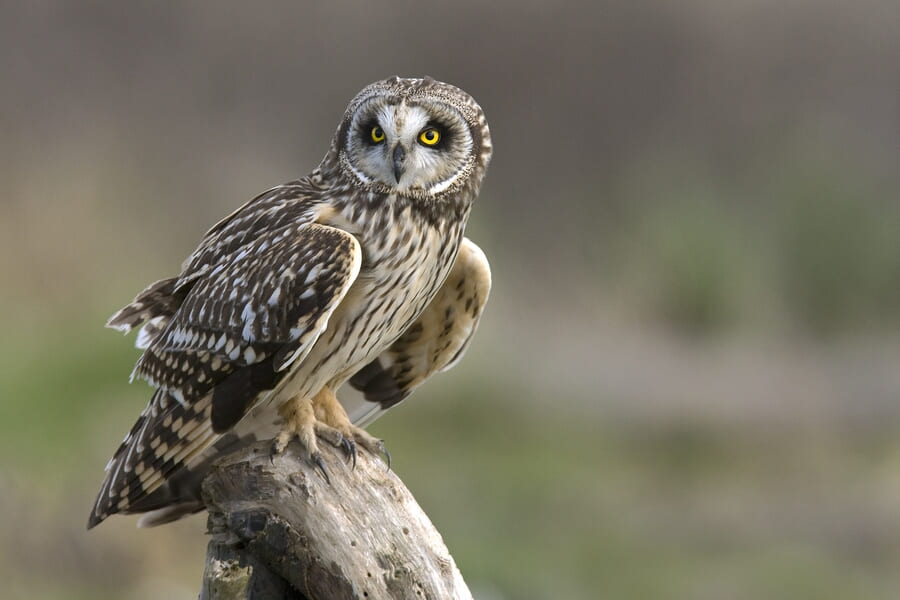
The owls’ faces are pale and have a whitish face disk. Their yellow eyes are surrounded by beautiful black rings that make it look like the bird is wearing mascara. Look for barred wingtips while the bird is flying. Juvenile Short-eared Owls look very similar to adults.
Although not very vocal, Short-eared Owls can make various sounds and calls. During the breeding season, the males give a series of quick hoots.
Both sexes may scream, whine, and bark. Nestlings give high-pitched begging calls. However, after they’ve reached seven days of age, the pitch of the call lowers.
Food
Short-eared Owls are completely carnivorous. They mostly eat small mammals such as voles, lemmings, and mice, sometimes rabbits and shrews, and on rare occasions even muskrats and bats.
In coastal regions, their diet includes a larger number of small birds and nestlings of terns, shorebirds, songbirds, and gulls. These owls supplement their diet with insects such as beetles, grasshoppers, and caterpillars.
Short-eared Owls mostly hunt at night or dawn or dusk, but these activities may extend into the daytime as well.
They use hearing and sight to hunt and have two hunting methods. If suitable perches exist, they will perch on one and survey the surrounding area. Once the prey has been located, they will take flight, snatch it up, and bring it back to the perch.
If there are no suitable perches, the owl slowly moves about six to five feet above the ground to detect prey. They may hover before dropping and snatching it up.
Once the prey has been caught, they will decapitate and eviscerate them, after which the owl will swallow it whole. If it’s a bird, they often remove their wings before consumption. Their ability to digest hard parts such as bone is reduced, so they eject pellets containing those remains.
Nesting and Eggs
Short-eared Owl pairs form from mid-February through June. In courtship display, males spiral into the air, give a series of hoots, dive, and loudly clap their wings together. They may also feed the female. Pairs are bonded and monogamous for the breeding season.
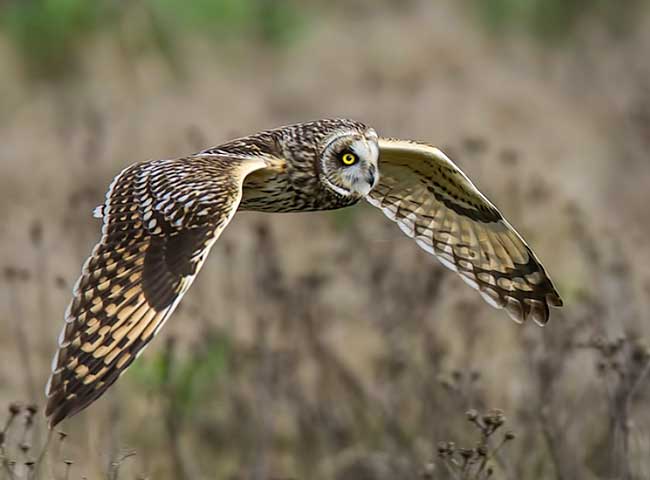
Short-eared Owls build their nests on a raised area on dry ground or very rarely above ground. It is usually hidden amongst vegetation or shrubbery so that it’s concealed from predators. Females scrape a depression into the ground and line it with grass and feathers. The completed nests are about 2 inches deep and 10 inches across.
These birds may have one to two broods in a year. They lay 1-11, mostly 6-8 white eggs that become stained as time goes on. Short-eared Owl eggs are about 1.5-1.7 inches long and 1.2-1.4 inches wide. The incubation process takes around 21-37 days and falls on the female. Males bring food to their partners during that time.
After the eggs have hatched, females continue to brood the nestlings and males continue to bring food. The father owl passes food to the female who then gives it to their younglings.
If the nest is threatened by an intruder or a predator, the adults may fly at them or sit on the ground and make themselves as big as possible. Young Short-eared Owls leave the nest after 12-18 days on foot and can fly at about 27-36 days. Parents will take care of them for a few more weeks after that.
Current Situation
Short-eared Owl’s range extends over all continents except for Australia and Antarctica. In the Americas, it covers almost all of North America, northern Central America, and a part of northern and most of southern South America.
They are year-round residents in South America and the middle of North America. Their breeding range covers Canada and Alaska, and they migrate to the southern United States and northern Central America for the winter.
Short-eared Owls inhabit open areas that do not have trees. Their preferred habitats include marshes and bogs, but they can also be found in prairies, dunes, tundra, farmlands, meadows, and other places that provide them with a suitable hunting area and a high number of prey items.
As of now, Short-eared Owls are listed as a species of least concern due to their extensive range and overall high numbers. However, some local populations are experiencing a decline due to several threats such as habitat loss.
Facts
- Although Short-eared Owls usually migrate medium distances for the winter or switch areas if their food source dwindles, then they may undertake much longer migrations of up to 1200 miles. They have been recorded to land on a ship in the middle of the Pacific Ocean, hundreds of miles from land, and inhabit remote islands.
- Short-eared Owls are very individualistic and solitary birds which creates an interesting situation during the breeding season. Males advertise themselves with aerial displays and wing clapping and they offer food to the female so that she wouldn’t consider the male as prey.
- The pair will try to protect their nest from intruders, which includes broken wing displays, attacking, and intimidation tactics. If they’re alone and are spotted, they may pretend to be dead.
Similar Species
These beautiful owls have some similar species. We have introduced two of them.
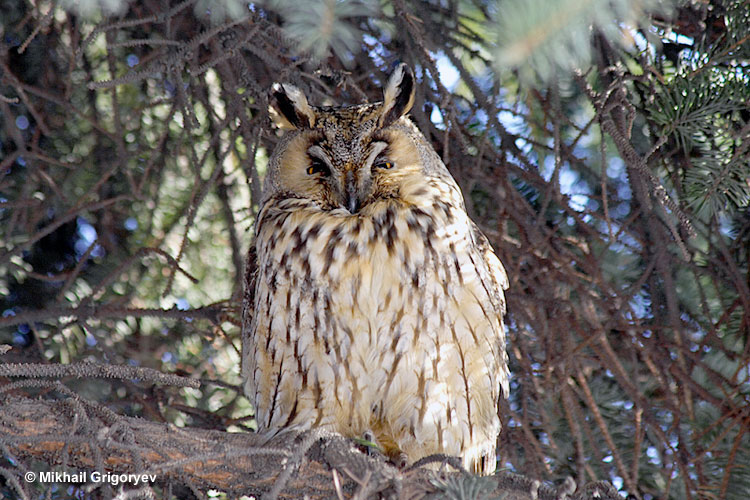
Long-eared Owl
Short-eared Owls and Long-eared Owls have similar overall plumage.
However, Long-eared Owls have longer ear tufts (hence the name) and a cinnamon facial disk instead of white.
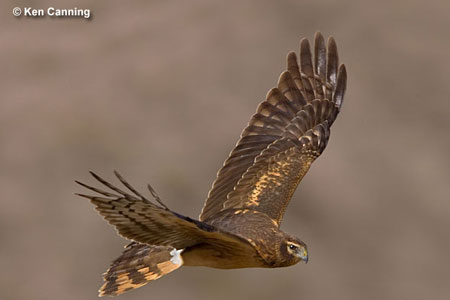
northern harrier
You might confuse these two when they’re hunting and flying since they hunt in the same habitats with a similar flight style.
However, Northern Harriers have smaller heads, more pointed wings, and longer tails.
Frequently Asked Questions
What is the common name for Short-eared Owl?
Short-eared Owls are commonly referred to as marsh owls, grass owls, and prairie owls.
How big is a Short-eared Owl?
Short-eared Owls are about crow-sized, measuring 13.4-16.9 inches long and having a wingspan of 33.5-40.5 inches.
What is the preferred habitat of the Short-eared Owl?
Short-eared Owls prefer open areas with no trees, especially marshes and bogs.
What time of day is best to see Short-eared Owls?
Short-eared Owls hunt at night but also near dawn or dusk. During the breeding season, they may also hunt during the day.

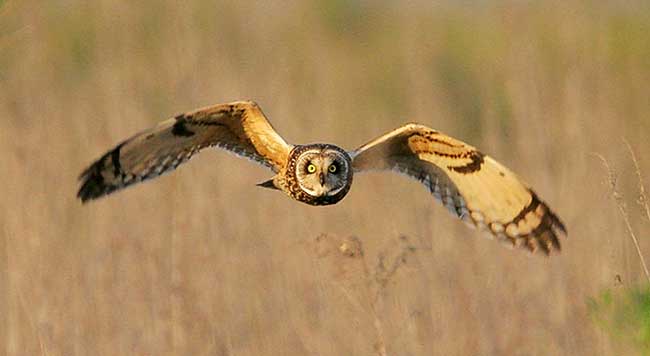
Robert (Bob) Sanders
Tuesday 12th of September 2023
Well done, very informative, quite accurate. Thanks.
Patrick O'Donnell
Monday 18th of September 2023
@Bob- Thanks, we're glad you liked it!